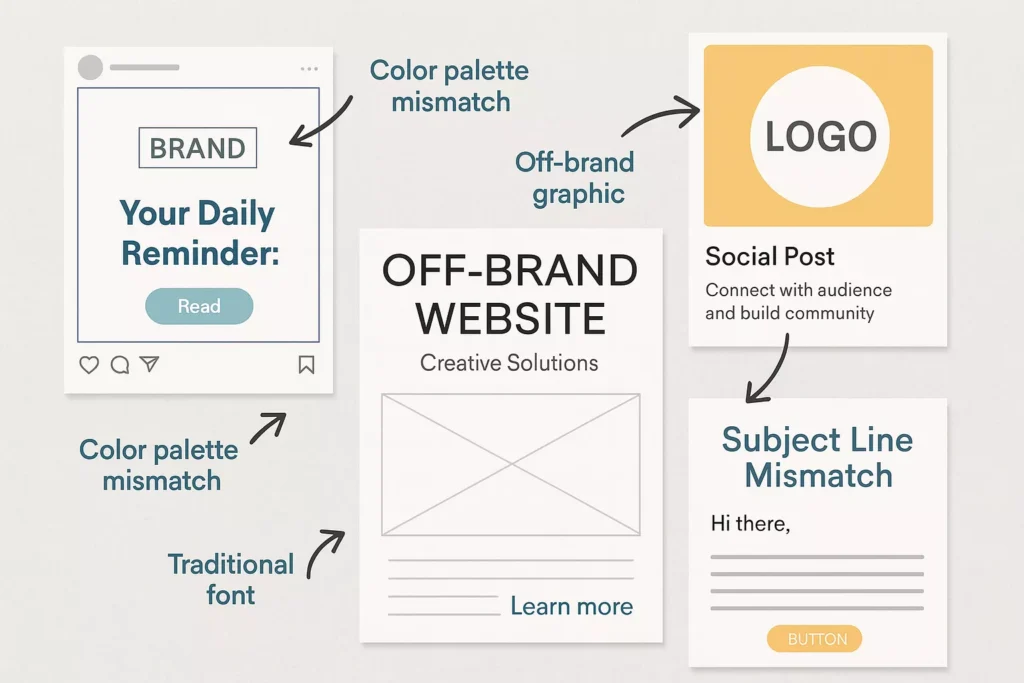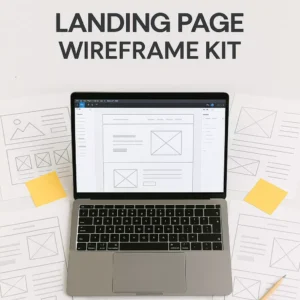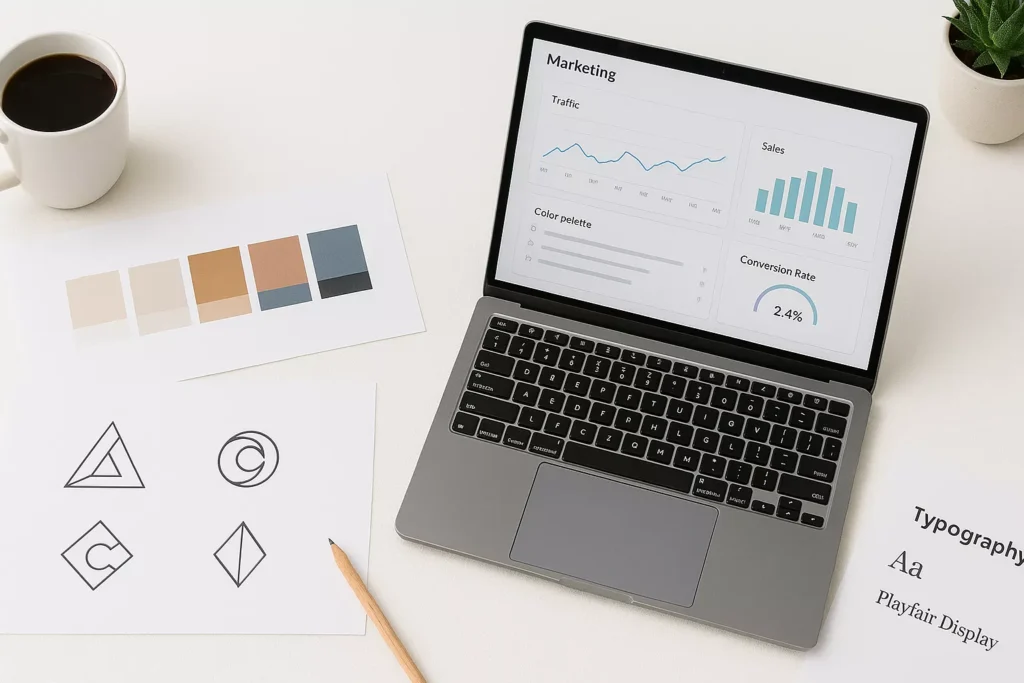Branding is more than just a logo or color palette — it’s the engine that drives recognition, trust, and pricing power for every small business.
Yet many entrepreneurs unintentionally undermine their brands by skipping strategy, copying competitors, or staying inconsistent across channels. The result? Forgettable brands, weaker conversions, and slower growth.
The good news — every one of these mistakes is fixable.
Let’s break down why branding fails, what’s causing it, and how you can turn it around with a few practical steps.
💡 Why Branding Fails Small Businesses

Branding fails when it’s treated as decoration instead of direction.
Without a clear strategy or understanding of the market, small businesses often end up blending in — not standing out. Inconsistent visuals, unclear messaging, and “me-too” marketing make potential customers feel uncertain or indifferent.
A strong brand, on the other hand, becomes your operating system — guiding recognition, trust, and loyalty from the first impression all the way through retention.
Winning brands aren’t just pretty — they’re positioned, consistent, and measurable.
❌ Mistake 1: Designing Before Defining
Starting with a logo or color palette before defining your audience, promise, and difference is like decorating a house before it’s built. Without strategy, every new asset (website, ad, or social post) pulls in a slightly different direction.
✅ Fix It: Strategy First
Create a one-page brand strategy that defines:
- Who you serve
- The problem you solve
- Why your solution stands out
Then gather real customer insights through short interviews, reviews, and competitor research. Use that language to shape your messaging — so your brand speaks the way your audience thinks.
Action Steps:
- Build a simple one-page brand strategy with your target audience, pain points, UVP, and promise.
- Run 5–10 quick customer interviews and 50 review analyses to find real-world phrasing and objections.
- Turn those insights into 3 core message pillars that guide all copy, ads, and landing pages.
❌ Mistake 2: Inconsistent Brand Identity

One tone on your website, another on Instagram, and a totally different one in your emails? That inconsistency confuses people and weakens trust.
It forces customers to re-learn who you are every time they see you — a silent conversion killer.
✅ Fix It: Create a Style Guide
A simple, accessible brand style guide is the secret to consistency. Include logo usage, color codes, typography, image direction, and tone of voice examples. Store all templates and brand assets in a shared folder, and audit your channels quarterly.
Action Steps:
- Build a concise brand guide with visuals and messaging examples.
- Centralize everything in one shared drive or brand library.
- Review top channels every quarter to fix inconsistencies.
❌ Mistake 3: Copying Competitors or Chasing Trends
Imitating big brands or following the latest visual trend makes your business invisible. You end up looking like everyone else — and fighting on price instead of value.
✅ Fix It: Be Distinct, Not Imitative
Find 2–3 unique cues that make your brand recognizable — your distinctive brand assets (DBAs). That could be a signature color combo, a shape, tagline, or tone. Test them with real people and use them everywhere.
Action Steps:
- Pick a few unique visual or verbal cues that represent your brand.
- Test which ones customers recall fastest and double down.
- Avoid fads — stay consistent with what builds recognition.
❌ Mistake 4: Unclear Messaging and Positioning

If a visitor can’t answer what you offer, who it’s for, and why it’s better within five seconds — they’ll leave.
Generic headlines and mixed messages confuse people and lower conversions.
✅ Fix It: Use a Message Spine
A strong message framework keeps every channel aligned. Use this pattern:
Category + Audience + Benefit headline → Core promise → 3 proof points → Clear CTA.
Action Steps:
- Craft a homepage headline in the “Category + Audience + Benefit” format.
- Pick one promise and three proof points to back it up.
- Standardize tone with “always say / never say” lists and CTA phrasing.
❌ Mistake 5: Weak Brand Governance
Without clear ownership or version control, small inconsistencies compound — low-res logos, off-tone copy, and old visuals make your brand look unprofessional.
✅ Fix It: Assign Ownership and Measure Results
Appoint a brand steward responsible for approvals, asset management, and quarterly reviews.
Create a mini-dashboard to track both brand metrics (search volume, direct traffic, recall) and performance KPIs (CTR, conversion rate, retention) to tie branding work directly to outcomes.
Action Steps:
- Assign one person or small team as brand owners.
- Maintain a simple KPI tracker and changelog.
- Audit external partners to ensure assets stay on-brand.
📈 Case Snapshots: What Works in Real Life
- Consistency Wins: Businesses that align their website, social media, and visuals under one style guide see better recall, smoother customer journeys, and higher conversion rates.
- Strategy-First Rebrands: Companies that start with a clear UVP and customer research create faster content and more unified campaigns.
- Governance Fixes: Having a single source of truth for assets cuts rework, improves quality, and protects your brand memory long-term.
🧩 30–60 Day Brand Reset Plan
Weeks 1–2: Strategy & Research
- Draft your one-page brand strategy and run quick customer interviews.
- Define your message pillars and tone of voice.
Weeks 3–4: Identity & Style
- Build a lean style guide and brand asset library.
- Refresh your homepage, key ads, and social templates.
Weeks 5–8: Governance & Measurement
- Assign a brand steward and set approval gates.
- Track key brand and performance KPIs.
- Standardize your 2–3 distinctive brand assets.
🎨 Build Distinctive Brand Assets (Without Big Budgets)
Distinctiveness isn’t about spending more — it’s about being consistent with fewer, stronger cues.
Pick recognizable elements like a unique color pair, a simple pattern, or a tagline that captures your promise. Then, repeat them across all channels until they become second nature to your audience.
Consistency compounds — the more they see it, the faster they remember it.
🗣 Clarity Converts Better Than Cleverness
When you’re still building awareness, clarity beats creativity every time.
Use straightforward headlines, strong promises, and proof points tied to customer outcomes. Keep CTA language consistent (“Download Now,” “Get Started,” “See How It Works”) to reduce friction and build momentum through the funnel.
⚙️ Operationalize Consistency
Make consistency easy, not manual. Use templates, locked styles, and automation tools to catch mistakes before they go live. Store all assets in one place and run short team refresh sessions every quarter.
This keeps quality high without adding overhead — a small change that has a massive impact over time.
📊 Measure What Matters
Track what your branding changes actually do for your business:
- Brand search and direct traffic (awareness)
- Click-through and conversion rates (performance)
- Retention and repeat purchases (loyalty)
Keep a simple changelog to connect improvements with results — proof that branding pays off.
Small businesses don’t fail at branding because of limited budgets — they fail because of unclear direction and inconsistency.
With a simple strategy, clear message, and repeatable assets, you can build a brand that’s trusted, recognizable, and scalable.
Branding isn’t decoration. It’s your growth system.
Start small, stay consistent, and let your brand do the heavy lifting for your business.





